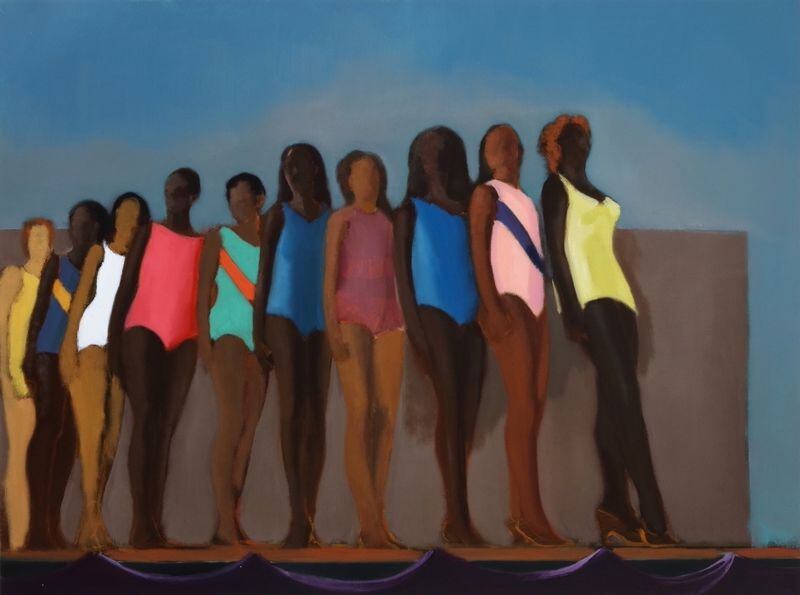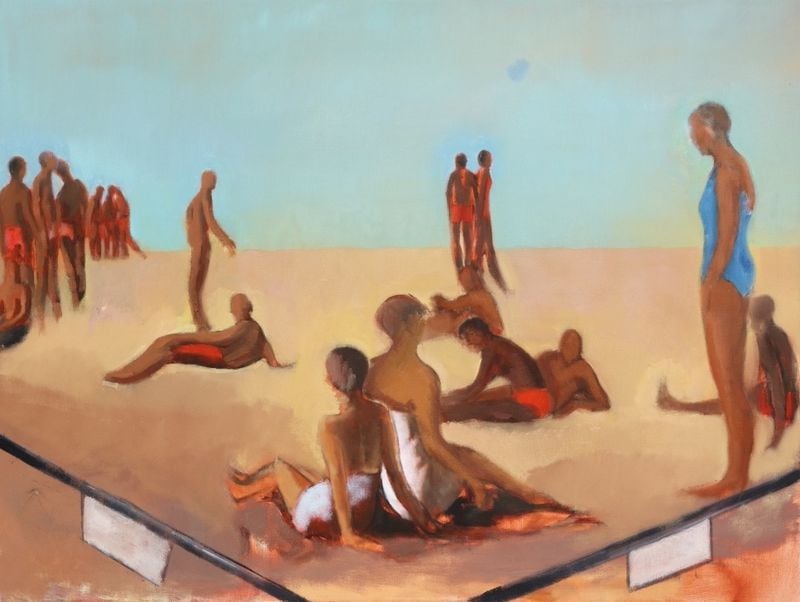An LA artist conjures up a romantic, elegant world of Black leisure
The Atlanta Journal-Constitution

If you didn’t know the full story you might mistake Braden Hollis’s paintings for the kind of sun-dappled art shilled in vacation towns: images of the seashore, lighthouses and families digging in the sand; or the high-altitude equivalent in Highlands, North Carolina, galleries offering up mountain trails, black bears and waterfalls. They are the spendier version in oils and acrylics of the postcards you tote home to remember a moment of bucolic escape.
Hollis’s paintings in her solo show “Paradise” feature volleyball players, sunbathers, beckoning bodies of water and lithe women in one-piece swimsuits. But while her paintings can appear innocuously pleasant, the 24-year-old Los Angeles artist is offering up a finely calibrated, look-closely-or-you-might-miss-it, vision of Black life.
More than just moments of recreational bliss, the athletic men and bathing beauties are inspired, says Hollis, by historian Alison Rose Jefferson’s book “Living the California Dream: African American Leisure Sites during the Jim Crow Era.” Hollis’s is an effort to visualize what is often ignored in American history: not just the pleasure and happiness in Black life but the growing recognition that America’s self-image as a melting pot has been very different in reality, with division and segregation more typical.
There is a distinctly timeless quality to Hollis’s work, blending midcentury modernism, rich Gauguin color ways and the preppiness of Slim Aarons’ photographs. The images in “Paradise” are evocative of another, more elegant time with these long-legged women in demure bathing suits cut low on the leg and broad-shouldered men. Class undoubtedly plays a part — bodies are noticeably free of doughiness or the whiff of hardship — the Black leisure class instead of the more commonly represented working class.

Though the artist works in oil, her brushwork is soft and downy and the result is an alluring pastel haziness that conveys the drowsy sensations of summer, of blinding sun bouncing off sand, blue-on-blue horizons and days of beachside languor.
UTA Artist Space gallery director Bridgette Baldo rightly calls Hollis an “old soul.” Like Alex Katz, her work can suggest the denizens of a discrete world or another LA artist Ferrari Sheppard’s paintings of little girls jumping rope, hip hop swagger and other iterations of Black joie de vivre. Like Sheppard, Hollis is all about the details we can infer since she leaves faces blank, preferring instead to conjure an idyllic shared memory. The anonymity in the paintings conjures up an idea of “everyman,” and the idea that Black life is normative not secondary.

In “Games played” a group of fit young men play beach volleyball, their identical blue bathing suits hinting at a time before the deluge of fast fashion choice, but also shared allegiance. Those men at play are answered in the more passive female entertainment shown in “My grandmother won the beauty competition.” In that work an assembly of eight beauty contestants are seen from a low angle, emphasizing the viewer’s status as “audience.” In their posture and the sashes worn by a few of the women we understand, even without the title, the social ritual at work. A favorite work in “Paradise” is “In Anticipation” of a diver in pink suit and bathing cap perched on a modernist plinth, her body crouched and ready to spring forward, a vision of optimism and grace. In Hollis’s hands “Paradise” is of her subjects’ making. It’s a world apart but with no sense of something lost.

“Paradise” can feel occasionally slight (the landscapes don’t necessarily advance the artist’s effort to give social underpinnings to all this beauty) but nevertheless seductive, dreamy and steeped in nostalgia.